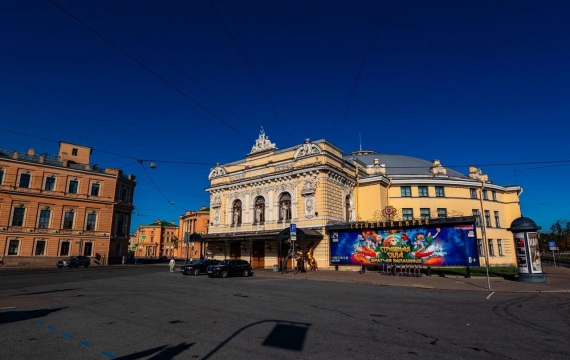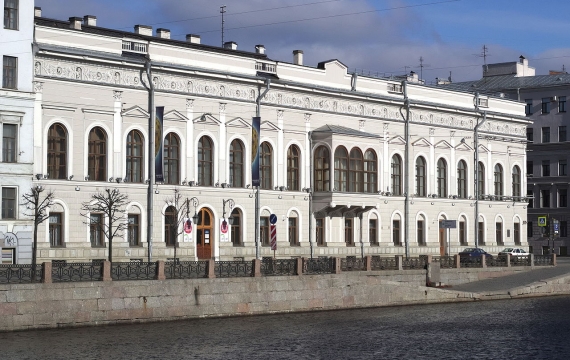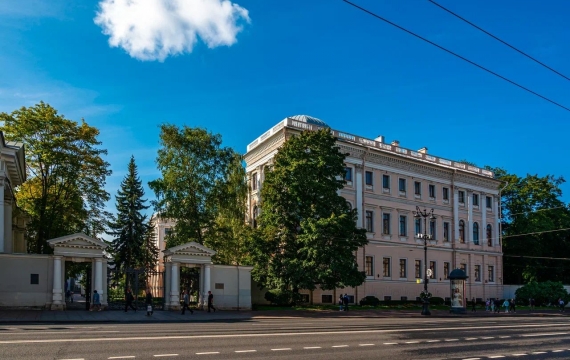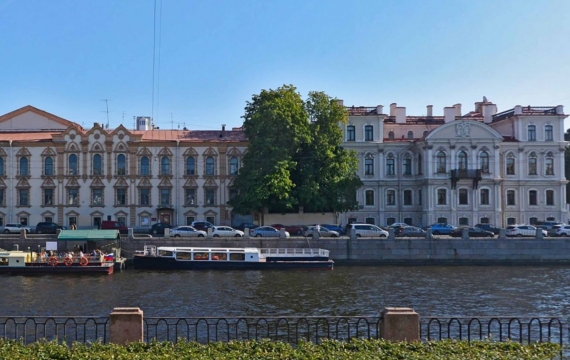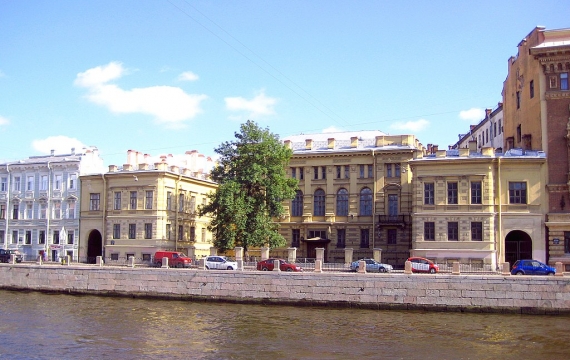Fontanka - the border of the ceremonial Petersburg
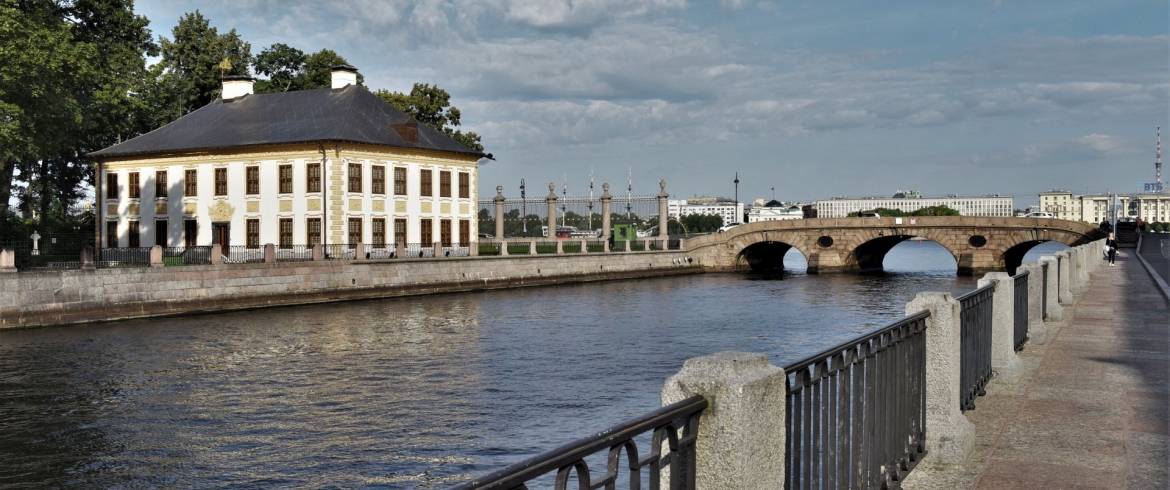
Start
Palace emb., 2
Travel time
45 min (calm step, excluding visits to museums)
Length
2,5km
Finish
Lomonosov sq.
sightseeing routes
What is this route?
Do you know that until the middle of the 18th century, the city border ran along the Fontanka, and even when it moved further, beyond the Obvodny Canal, Fontanka remained the southern border of ceremonial Petersburg? And in Peter's times it was a shallow swamp river named Bezymyanny Erik - the river got its current name from the fountains of the Summer Garden.
... No, the water for the fountains was not taken from the Fontanka - it was supplied through the Ligovsky Canal, in the place of which is now Ligovsky Prospect. The canal ended with an artificial pool at the corner of Basseinaya Street (now Nekrasova), from where it was piped into the Summer Garden. But the pipes were laid over the aqueduct bridge across the Fontanka!
In the 18th century, the river was cleared and deepened, the channel was straightened, embankments were built - first wooden, and then granite. In the 1780s, seven bridges of the same type were thrown across the Fontanka: Simeonovsky, Anichkov, Chernyshev, Obukhovsky, Izmailovsky, Semenovsky and Kalinkin. And they were all - according to the standard design of the French engineer Jean-Rodolphe Perrone - similar, like twin brothers: with granite turrets and adjustable chain mechanisms. Later, most of them were rebuilt.
Today, there are only two such bridges over the Fontanka, and you will get to know one of them - the Lomonosov Bridge (formerly Chernyshev) on this route.
Note!
You can travel around St. Petersburg on your own with a smartphone in hand, or you can sign up for one of the detailed and exciting excursions from our Tour Bureau. Among other things, our guides conduct walking tours "The Stories of the Fontanka River".
You can choose, order and pay for a city tour with an experienced local historian, an expert on the history and architecture of St. Petersburg, in the "Excursions" section.
The cost of a walking tour is 3390 rubles. for a group of 1-4 people + 500 rubles. for each additional guest.
What can you expect?
The journey begins at the Palace Embankment, at the Laundry Bridge, one of the first stone bridges in St. Petersburg. There were palace laundries nearby - hence its unusual name.
Then a leisurely stroll through the Summer Garden awaits you. In the Petrine era, it was decorated with many fountains - they were destroyed by a powerful flood in 1777, and at the same time the aqueduct through which water was supplied was damaged. And there was an aqueduct on the site of the current Panteleimonovsky bridge, to which you now went, having passed through the Summer Garden.
On the left is the Panteleimon Church, one of the oldest Orthodox churches in St. Petersburg, which gave its name to the bridge. And this bridge was also called the Chain Bridge - after all, this is exactly what it was from 1824 to 1905, until it was rebuilt ... just in case. What if it also collapses, as the Egyptian bridge of a similar design collapsed in 1905?
An inconspicuous house on the left bank of the Fontanka was also called the building "at the Chain Bridge". Inconspicuous, but ominous, because the Third Section of His Imperial Majesty's Chancellery, the body of the political investigation of the Russian Empire, was located here.
And your path lies along the right bank of the Fontanka, past the majestic Mikhailovsky (Engineering) castle. After crossing the Moika River flowing from the Fontanka along the First Engineering Bridge, do not forget to throw a coin for luck to Chizhik-Pyzhik ... And here is another Engineering Bridge - Second. It is interesting in that it does not connect any shores, passing over a piece of land. Once there was one of the canals that surrounded the castle of Paul the First.
Ahead is the Ciniselli Circus, the first stone circus building in our country, one of the most beautiful in Europe, and on the left is the Belinsky Bridge, the former Simeonovsky Bridge, one of the seven twin bridges of J.R. Perrone and one of the five that have not preserved their turrets. Cross to the left bank, take a look at the old church of Simeon and Anna, which gave the name to the bridge.
Having reached the Sheremetyevsky Palace, also known as the Fountain House, look into the courtyard, to the left, and pay attention to the gate with the coat of arms of the Sheremetev family. Two lions are holding a shield, and under it is the motto: Deus conservat omnia (God preserves everything). Anna Akhmatova, who lived here, in the wing of the Fountain House, took these words as an epigraph to her Poem Without a Hero.
The building of the Catherine Institute for Noble Maidens was built at the beginning of the 19th century according to the design of Giacomo Quarenghi. Today it is one of the buildings of the Russian National Library. Opposite, across the Fontanka, is the light and graceful palace of the Naryshkins-Shuvalovs in the neo-Renaissance style. Today it houses the Faberge Museum.
The Anichkov Bridge with the famous sculptural groups - the horses of Peter Klodt - needs no special introduction. It's hard to believe, but once it was typical, with the same turrets.
To the right and to the left of the bridge are two magnificent palaces, red and white: the Beloselsky-Belozersky palace and the Anichkov palace. The name of this palace and bridge comes from the surname of Lieutenant Colonel-Engineer Mikhail AnIchkov, whose battalion was located in these places during the time of Peter I and built the first bridge across the Fontanka along the axis of the Nevskaya prospect.
Pay attention to the building of the Mayakovsky Library. In the first half of the 18th century, when the border of St. Petersburg passed along the Fontanka, the country estates of noble townspeople were located on the left bank. The existing building in the neo-Russian style appeared in the middle of the 19th century - it was occupied by the courtyard of the Trinity-Sergius Lavra.
The grandiose arches of the Tolstoy House - an example of the Northern Art Nouveau style by the famous Fyodor Lidval - will lead you into the courtyards, a whole huge city of courtyards, between Fontanka and Rubinstein Street. Local residents - wealthy owners of luxury apartments - are not very happy about excursions, but they have nothing against single tourists.
And now, finally, in front of you is the Lomonosov Bridge (formerly Chernyshev), which has retained its architectural appearance (and turrets!) Since 1787. There are only two such bridges left on the Fontanka: Lomonosov and Staro-Kalinkin. But you will not get to the last one today - it is far away, almost at the very mouth of the river. You will cross the Fontanka and find yourself on Lomonosov Square (Chernysheva), whose classical architectural ensemble was created in the 1830s by the great architect Karl Rossi.
Your route along the banks of the Fontanka River ends here.












